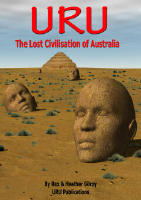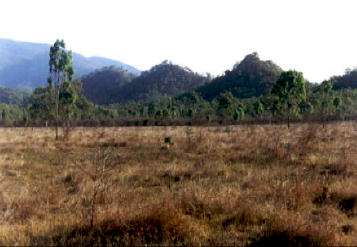Atlantis Rising - Return Of The Lost Gods [continued]
Or for the home ports when the mining colonies were abandoned, in the wake of the Colonists’ own civilisation’s collapse in the Old World. The power of the Uruan monarchs waned with the arrival and peaceful or otherwise occupation of the land by the newcomers, who also introduced advanced astronomical instrumentation, such as the cross-staff and other simplified inventions, which overnight would have made the erection of great alignments of standing stones unnecessary as we have seen.
Thus masses of workers were no longer needed and the megalithic sites fell into disuse. It is also possible that around this time Uruan astronomers might have developed a more advanced instrumentation of their own which we have yet to discover.
Perhaps as the Aboriginal population increased, their attacks on isolated communities would have forced the Uruans to abandon these areas for larger populated centres elsewhere.
And as the heartland of Australia became arid with the drying up of the rivers and lakes in the last stages of the Ice-Age, the Uru would have abandoned the interior for moister regions closer to the coast.
The submergence of the land-bridges, which saw great culture centres vanish beneath the rising seas, particularly between New Guinea southward to New Zealand [ie Wainga-roa] certainly had a devastating effect upon the displaced Uru of those regions, and much later, the great Taupo volcanic eruption, yet all these events in themselves would not have been enough to totally destroy this civilisation.
The great migrations northward beyond Australia, which saw the spread of the civilisation across the Old World, and eventually across the Pacific to the Americas, would have reduced the population somewhat at home, yet as late as the arrival of the Bronze Age colonists, the Uruan monarchs could still command great numbers of people to erect their monuments. And there is evidence that the Uru lingered on in many parts of Australia long after the departure of the visitors, erecting temples and astronomical observatories, where their astronomer priests worked with the more simplified wooden instruments.
The occasional discoveries of ancient hand-grounded magnifying crystal lenses at widely-scattered locations across Australia could suggest Uruan astronomers had developed the crudest of telescopic devices. The questions surrounding the disappearance of the Uru are similar to those often raised by archaeologists worldwide, concerning the mystery disappearances of other great cultures, in the Americas and elsewhere. Perhaps the disappearance of the Uru and their civilisation was due to many progressive causes over a vast period of time.
Yet what became of the people themselves? Certainly they would have inter-mixed with the peoples they influenced beyond Australia, but their final disappearance in Australia remains an unsolved mystery, lost in the drifting sands of the silent Australian landscape. Heather and I continue to uncover new sites of the Uru around Australia, and as our work progresses we will undoubtedly find answers to many of the puzzles surrounding this remarkable people, altering previous conclusions.
Australantis is rising from its long submergence in the swirling mists of time, and the lost gods of old Uru are returning as each is revealed with the discovery of every faded rock inscription that bears their names. The hitherto unknown names
of kings and queens of the true
Atlantis - Uru, are also emerging from
the rock inscriptions, to reveal highly
organised kingdoms ruled by
monarchs who in many cases, appear
to have wielded considerable power.
The dates involved is one problem
awaiting a solution. We can at least
presently assign these rulers to any of
the eight identified Uruan script
developments [ie see Introduction].
The time periods in which each
of these scripts were in use are
considerable, and for now there is no
way to narrow them down to obtain
any idea of the lengths of reigns of
individual monarchs.
There is evidence that isolated
Uruan populations persisted in
Australia to a surprisingly late period.
Long after the Bronze-Age had given
way to that of the Iron, by 2000 years
ago and later, Irish Celts preserved
traditions of the “lost paradise” that
lay in the southernmost region of the
world, ruled over by a race of superior
beings who were devotees of the
Serpent Cult, and which the Celtic
peoples generally regarded as their
ancestors, the Uruans.
These traditions
were still commonplace in the 3rd
century AD.
In the 12th century and before,
many largely unsung Mediaeval
European traders and travellers
penetrated to Asian ports, sailing much
farther afield than the over-rated
Marco Polo [1254-1324] to reach
Australia, and it also appears, New
Zealand. These unknown epic voyages
are fully described in my book“Pyramids in the Pacific”. These brave
seafarers returned to Europe with tales
of the “Lost Paradise” and the race of ‘idolators’ who lived there. Such
reports persisted as late as the 15th
century.
One ‘unknown’ voyage to
these shores is that of Sir Owain Miles,
a Welsh knight who had served King
Stephen of Blois, who ruled England
from 1135-1154. In 1155 with a large
retinue of followers, and having
crossed over Europe, Sir Owain Miles
sailed from the Red Sea with two or
three ships in search of the “Lost
Paradise”. His expedition sailed first to
India, and after replenishing supplies,
voyaged southward. After many
adventures in island south-east Asia
the vessels reached the ‘Lost Paradise’,
“a land of heat and flies” as Sir Owain
Miles aptly described Australia!
The Welshmen appear to have
landed somewhere in Australia’s far
north, where they meet up with
numbers of black men, and strange
birds and animals. Venturing further,
along what appears to be our east
coast, they explore deep inland where
they meet a priestly caste of men.
Nearby stretches a great lake, amid which there rises a spiral mount [or
could it have been a terraced
pyramid?], around which they observe
people walking to the summit to
receive spiritual enlightenment [they
are informed]. Where might this spiral
mount amid the lake have been? And
who were the mysterious inhabitants?
Had Sir Owain Miles and his followers
come upon a surviving Uruan culture
centre? His expedition sailed on,
returning home after a ten-year
absence with his incredible tale. Yet it
is not the only one of its kind from
that era. Perhaps the Uruan culture still
survived in widely-scattered areas in its
final days, yet though their passing
went unnoticed, their forebears had
long before laid the foundations of
modern civilisation

 Terraced Hill
Terraced Hill 


 Pyramid Hill
Pyramid Hill  Pyramid Hill
Pyramid Hill  Pyramid Hill
Pyramid Hill 